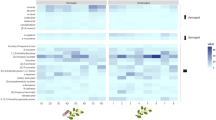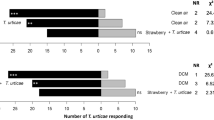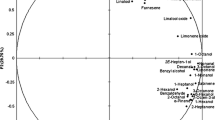Abstract
Previous work showed that anthocorid predators aggregate around gauze cages containing Psylla-infested trees in a pear orchard. Because anthocorids responded to odor from Psylla-infested leaves in a laboratory test, it was hypothesized that these aggregative responses in the field were triggered by olfaction of compounds associated with Psylla injury. We present chemical analyses of volatiles from damaged and undamaged plants and studies on behavioral responses of anthocorid predators to compounds released by damaged plants. Leaf headspace volatiles from clean and Psylla-infested pear trees were collected on Tenax and identified by GC-MS after thermodesorption. Twelve volatiles were found exclusively in headspace samples from Psylla-infested leaves. Six were present in significantly higher quantities in samples from infested leaves: the monoterpene, (E,E)-α-farnesene, the phenolic, methyl salicylate, and the green leaf compounds, (Z)-3-hexen-1-yl acetate, (Z)-3-hexen-1-ol, 1-hexyl-acetate, and 1-penten-3-ol. These compounds are known to be produced by plants, and damage by pear psyllids seems to trigger their emission. Blend composition varied and was partly correlated with tree or leaf age and degree of Psylla infestation. To study whether compounds associated with leaf injury elicit olfactory responses in anthocorid predators, apple-extracted (E,E)-α-farnesene, synthetic methyl salicylate, and (Z)-3-hexen-1-yl acetate were offered in a Y-tube olfactometer to field-collected adult Anthocoris spp. Significant positive responses were found to both the monoterpene and the phenolic, but not to the green leaf volatile. The results lend support to the hypothesis that predator attraction to herbivore-infested pear trees is mediated by herbivory-induced plant volatiles.
Similar content being viewed by others
REFERENCES
BLAAKMEER, A., GEERVLIET, J. B. F., VAN LOON, J. J. A., POSTHUMUS, M. A., VAN BEEK, T. A., and DE GROOT, Æ. 1994. Comparative headspace analysis of cabbage plants damaged by two species of Pieris caterpillars: Consequences for in-flight host location by Cotesia parasitoids. Entomol. Exp. Appl. 73:175–182.
BOEVE, J.-L., LENGWILER, U., TOLLSTEN, L., DORN, S., and TURLINGS, T. C. J. 1996. Volatiles emitted by apple fruitlets infested by larvae of the European apple sawfly. Phytochemistry 42:373–381.
DICKE, M., and SABELIS, M. W. 1988. Infochemical terminology: Should it be based on cost-benefit analysis rather than origin of compounds? Funct. Ecol. 2:131–139.
DICKE, M., VAN BEEK, T. A., POSTHUMUS, M. A., BEN DOM, N., VAN BOKHOVEN, H., and DE GROOT, Æ. 1990a. Isolation and identification of volatile kairomone that affect acarine predator-prey interactions. J. Chem. Ecol. 16:381–396.
DICKE, M., VAN DER MAAS, K. J., TAKABAYASHI, J., and VET, L. E. M. 1990b. Learning affects response to volatile allelochemicals by predatory mites. Proc. Exp. Appl. Entomol., NEV Amsterdam 1:31–36.
DICKE, M., BRUIN, J., and SABELIS, M. W. 1993. Herbivore induced plant volatiles mediate plant-carnivore, plant-herbivore and plant-plant interactions: Talking plants revisited, pp. 182–196, in J. C. Schultz and I. Raskin (eds.). Plant Signals in Interactions with other Organisms, Current Topics in Plant Physiology, American Society of Plant Physiologists Series, Vol. 11, Rockville, Maryland.
DRUKKER, B., and SABELIS, M. W. 1990. Anthocorid bugs respond to odours emanating from Psylla-infested pear trees. Proc. Exp. Appl. Entomol., NEV Amsterdam 1:88–89.
DRUKKER, B., SCUTAREANU, P., BLOMMERS, L. H. M., and SABELIS, M. W. 1992. Olfactory response of migrating anthocorids to Psylla-infested pear trees in an orchard. Proc. Exp. Appl. Entomol., NEV Amsterdam 3:51–56.
DRUKKER, B., SCUTAREANU, P., and SABELIS, M. W. 1995. Do Anthocorid predators respond to synomones from Psylla-infested pear trees under field conditions? Entomol. Exp. Appl. 77:193–203.
DWUMFOUR, E. F. 1992. Volatile substances evoking orientation in the predatory flowerbug Anthocoris nemorum (Heteroptera: Anthocoridae). Bull. Entomol. Res. 82:465–469.
HARDIE, J., ISAACS, R., PICKETT, J. A., WADHAMS, L. J., and WOODCOCK, C. M. 1994. Methyl salicylate and (—)-(1R,5S)-myrtenal are plant-derived repellents for black bean aphid, Aphis fabae Scop. (Homoptera: Aphididae). J. Chem. Ecol. 20:2847–2855.
HAUKJOJA, E. 1990. Induction of defenses in trees. Annu. Rev. Entomol. 36:25–42.
JENNINGS, W. G., LEONARD, S., and PANGHORN, R. M. 1960. Volatiles contributing to the flavor of Bartlett pears. Food Technol. 14:587.
LEWIS, W. J., and TUMLINSON, J. H. 1988. Host detection by chemically mediated associative learning in a parasitic wasp. Nature 331:257–259.
MATTIACCI, L., DICKE, M., and POSTHUMUS, M. A. 1994. Induction of parasitoid attracting synomone in Brussels sprouts plants by feeding of Pieris brassicae larvae: Role of mechanical damage and herbivore elicitor. J. Chem. Ecol. 20:2229–2247.
MC CALL, P. J., TURLINGS, T. C. J., LEWIS, W. J., and TUMLINSON, J. H. 1993. Role of plant volatiles in host location by the specialist parasitoid Microplitis croceipes Cresson (Braconidae, Hymenoptera). J. Insect Behav. 6:625–639.
MC CALL, P. J., TURLINGS, T. C. J., COUGHRIN, J., PROVAUX, A. T., and TUMLINSON, J. H. 1994. Herbivore-induced volatile emissions from cotton (Gossypium hirsutum L.) seedlings. J. Chem. Ecol. 20:3039–3050.
MC LAFFERTY, F. W., and STAUFFER, D. B. (eds.). 1989. Wiley/NBS Registry of Mass Spectral Data. John Wiley & Sons, New York.
MILLER, R. L., BILLS, D. D., and BUTTERY, R. G. 1989. Volatile components from Bartlett and Bradford pear leaves. J. Agric. Food Chem. 37:1476–1479.
PRICE, P. W., BOUTON, C. E., GROSS, P., MC PHERON, B. A., THOMPSON, J. N., and WEIS, A. E. 1980. Interactions among three trophic levels: Influence of plant on interactions between insect herbivores and natural enemies. Annu. Rev. Ecol. Syst. 11:41–65.
SABELIS, M. W., and VAN DE BAAN, H. E. 1983. Location of distant spider mite colonies by phytoseiid predators: Demonstration of specific kairomones emitted by Tetranychus urticae and Panonychus ulmi. Entomol. Exp. Appl. 33:303–314.
SCUTAREANU, P., DRUKKER, B., and SABELIS, M. W. 1993. Migration of anthocorid bugs to Psylla infested pear trees. Med. Fac. Landbouww, Rijksuniv. Gent 58:447–451.
SIEGEL, S. 1956. Nonparametric Statistics for the Behavioral Sciences. McGraw-Hill, Tokyo.
TAKABAYASHI, J., and DICKE, M. 1996. Plant-carnivore mutualism through herbivore-induced carnivore attractants. TIPS 1:109–113.
TAKABAYASHI, J., DICKE, M., and POSTHUMUS, M. A. 1991. Variation in composition of predator attracting allelochemicals emitted by herbivore-infested plants: Relative influence of plant and herbivore. Chemoecology 2:1–6.
TAKABAYASHI, J., DICKE, M., TAKAHASHI, S., POSTHUMUS, M. A., and VAN BEEK, T. A. 1994. Leaf age affects composition of herbivore-induced synomones and attraction of predatory mites, J. Chem. Ecol. 20:373–386.
TALLAMY, D. W., and RAUPP, M. J. (eds.). 1991. Phytochemical Induction by Herbivores. John Wiley & Sons, New York.
TURLINGS, T. C. J., and TUMLINSON, J. H. 1992. Systemic release of chemical signals by herbivore-injured corn. Proc. Natl. Acad. Sci. U.S.A. 89:8399–8402.
TURLINGS, T. C. J., TUMLINSON, J. H., and LEWIS, W. J. 1990. Exploitation of herbivore-induced plant odors by host-seeking parasitic wasps. Science 250:1251–1253.
TURLINGS, T. C. J., TUMLINSON, J. H., HEATH, R. R., PROVEAUX, A. T., and DOOLITTLE, R. E. 1991. Isolation and identification of allelochemicals that attract the larval parasitoid Cotesia marginiventris (Cresson) to the microhabitat of one of its hosts. J. Chem. Ecol. 17:2235–2251.
VAN DE BAAN, H. E., and CROFT, B. A. 1991. Resistance to insecticides in winter and summer forms of pear psylla, Psylla pyricola. Pestic. Sci. 32:225–223.
WATSON, T. K., and WILDE, W. A. H. 1963. Laboratory and field observations on two predators of pear psylla in British Columbia. Can. Entomol. 95:435–438.
WHITMAN, D. W., and ELLER, F. J. 1990. Parasitic wasps orient to green leaf volatiles. Chemoecology 1:69–75.
Author information
Authors and Affiliations
Corresponding author
Rights and permissions
About this article
Cite this article
Scutareanu, P., Drukker, B., Bruin, J. et al. Volatiles from Psylla-Infested Pear Trees and Their Possible Involvement in Attraction of Anthocorid Predators. J Chem Ecol 23, 2241–2260 (1997). https://doi.org/10.1023/B:JOEC.0000006671.53045.16
Issue Date:
DOI: https://doi.org/10.1023/B:JOEC.0000006671.53045.16




